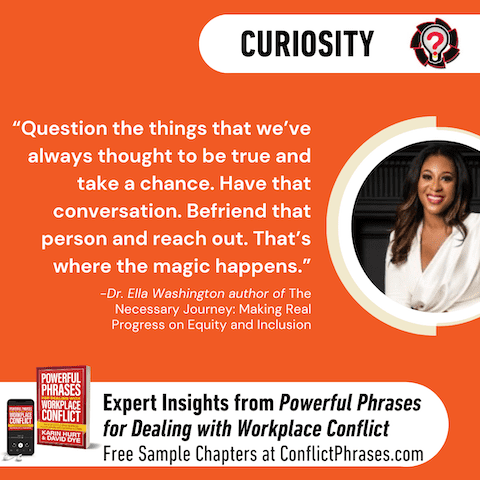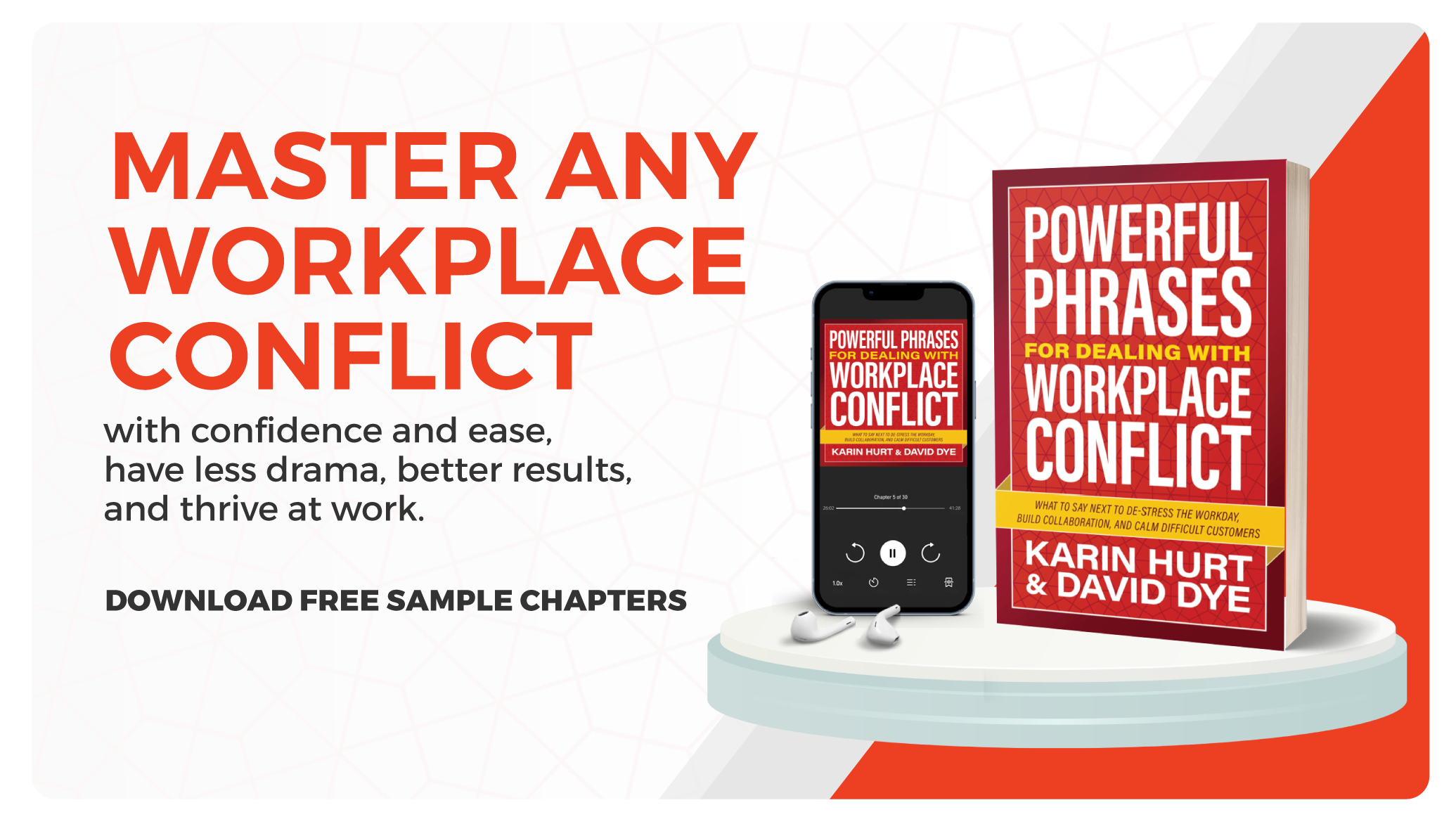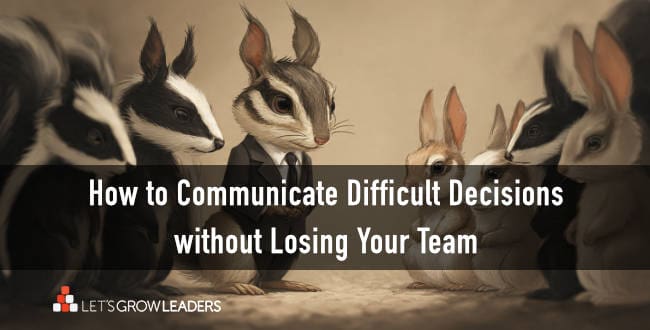Navigate political conflict at work with a combination of clarity, connection, and curiosity
When you think of talking with people at work who have different political beliefs, your first response might be like that of many people we’ve encountered as we wrote Powerful Phrases for Dealing with Workplace Conflict: “Yeah, no. I’m just not going there. Better to play it safe than say something wrong.” After all, who wants more political conflict at work?
We get it. In a post-pandemic world where social and traditional media contribute to polarization, workplace conflict that stems from differing politics, worldviews, and values can feel scary and overwhelming.
How did THAT Get Political?
You can hear the tension in the voice of many managers and leaders who call to ask for advice. “We’ve got a presidential election coming up and I’m worried about the polarization and potential political conflict. Do you have any advice?”
It’s easy to understand their concern. Just this past week, we saw a range of seemingly “normal” online conversations turn political (with people explicitly assuming, labeling, and insulting one another’s political affiliation).
What were these juicy conversation topics, you ask?
- Taylor Swift
- Workplace performance reviews
- Cheering on a sports team that’s not your usual team
- Whether hens lay eggs with or without the presence of a rooster (No joke! This truly degenerated into political party name-calling).
Wow.
If an egg-laying conversation can turn into ugly political conflict, what are we to do with more serious subjects that might come up at work like global warming, regulatory change, health and wellness of customers and employees, international wars, human rights, and so much more?

Political Conflict at Work by the Numbers
In our World Workplace Conflict and Collaboration Survey of 5,000+ people in 45+ countries surveyed and all 50 US states, 70% of respondents to the survey say that in the last couple years, they’ve experienced the same or more frequent conflict in the workplace.
And of those, 9% cite political conflict as a top contributing factor. 20% cite less tolerance or understanding for others as a top contributing factor of workplace conflict (which speaks to polarization). And there’s more data that suggests the rate of political conflict at work will only increase.
But even (or especially) in these moments, there are practical tools and Powerful Phrases that can help you navigate, communicate, and collaborate.
Turn Down the Heat on Political Conflict at Work
Let’s begin with a few foundational mindsets that will help calm political conflict at work.
Different perspectives aren’t always “toxic.”
“Toxic” is one of those words that have had runaway success on social media because it’s easy to label something as toxic and then ignore or “cancel” the person. (And this behavior isn’t confined to one group or another.) The problem is that when we automatically reject or ignore anyone with a significantly different approach to life, we eliminate any chance that we’ll learn from one another.
Realistically, in any organization, you’re going to have different perspectives. Hopefully, your organization has a set of common values, approach to the work, and how you support your customers and one another. These shared values and approaches give you an important way to work through different worldviews.
That other person is a human being.
Keeping one another’s humanity in mind helps us stay in a place of curiosity and compassion. That person with their incomprehensible position is an imperfect person, possibly worried or scared, and doing the best they can. Just like you.
This mindset helps you stay connected and curious. Think about the pandemic. One person was scared and worried because of the illness. While another person was scared and worried because of curtailed personal freedoms. Both were very human in their fear and worry.
You aren’t there to change their mind.
Your self-evident beliefs are just as self-evidently wrong to someone else. Trying to force someone to abandon their beliefs doesn’t work. Political views are often part of a person’s identity and that doesn’t change quickly.
You probably wouldn’t appreciate it if someone at work spent all day trying to convince you that you’re wrong-headed and mistaken for voting the way you do. And neither do they.
8 Approaches for Dealing with Political Conflict at Work
These are actions, mindsets, and specific powerful phrases you can use before and during the conversation.
1) You don’t have to discuss politics at work.
“I don’t discuss politics and work.”
“I prefer to focus my conversations on our work together and how we’re serving our clients, constituents, or customers.”
These are straightforward statements that stand on their own.
2) Focus on learning.
“My intent for this conversation is… so that…”
If you do choose to engage in conversation that could lead to political conflict at work, you can minimize potential conflict by showing up with curiosity – and stating that from the start. Again, you’re not there to change someone’s mind.
Focus on asking genuine questions that help you understand how they came to their conclusions. You might even find something you share – a commitment to your children, for example.
For example, “My intent for our conversation is to learn more about where you’re coming from with your support for those regulations so that I can understand why they’re important.”
When you start a conversation with your honest intent, it opens a door. The other person can choose whether they want to walk through that door and get the available benefit. That honest intent also makes it clear from the beginning that you’re not trying to change their mind or take away a closely held value.
3) Show up with confidence and humility.
“I’ve noticed that we have different perspectives . . . and would love to learn more.”
This one “lands in the and”: confidently observing the differences with the humility to adopt a posture of learning. Approaching different world views with curiosity lessens the “fight or flight” reflexes people experience when confronted with something strange. When you ask to learn more, you don’t promise to change your mind. Rather, you are seeing them and giving yourself a chance for deeper appreciation. “Tell me more,” is one of our G.O.A.T. Powerful Phrases in our new book.
4) Don’t assume.
“Have you asked?”
In our podcast interview of Dr. Ella Washington, author of The Necessary Journey, she shared a wonderful story about questioning one’s assumptions.
We all have bias and stereotypes. We all make assumptions. But what if we take these micro-moments every single day and question some of our own assumptions?
Fawn Weaver, the founder and CEO of Uncle Nearest Premium Whiskey, shared one of her favorite examples with me. Her husband’s family moved to Nashville from California and their next-door neighbor was a white man. He had a big truck, long beard, and tattoos. Her mother-in-law told Weaver that the man seemed like somebody who didn’t like Black people. Weaver was curious and said, “Have you asked him?”
She went next door and talked to the guy. He was very open, friendly, and was listening to some of her favorite R&B songs. That’s so inspiring.
Question the things that we’ve always thought to be true and take a chance. Have that conversation. Befriend that person and reach out. That’s where the magic happens.
5) Keep political conversations off message threads.
“Chat and message threads are best suited to low-bandwidth conversations where there are quick transactions and not much emotion. Let’s keep the important topics and decisions in our voice-to-voice or face-to-face conversations.”
Comments and chats are horrible ways to engage in political conversations. (For proof, look at almost any comment thread on the internet – including those conversations about chickens and eggs.)
6) Share your perspective.
“So, what you’re saying is . . . Do I have that right? That’s interesting. And I see it differently.”
As you listen and learn where another person comes from, first check for understanding. For example, “I hear you saying you’re concerned about your children’s future and growing up in a world where they can’t go outside without getting sick. Do I have that right?”
Then you can share your perspective—not intending to change their mind, but to contribute equally, and confidently, to the conversation.
For example, “I see what you’re saying. I’m worried about my kids’ future too. My concern is that we won’t have any work available for them because it’s gone to other countries that don’t have the same values we do.”
7) Stand up to political bullies.
“We have a variety of beliefs and need different perspectives to do our best work.”
We define political bullies as people who loudly proclaim their beliefs and belittle anyone who doesn’t agree with them. This is the person who brashly proclaims, “[Candidate] is an idiot and anyone who votes for them should have their head examined.” (A direct quote from a leader in one of our prior workplaces.)
This kind of proclamation, especially from people in leadership roles, shuts down dialog, and damages trust and psychological safety. If you have a relationship with the person who made the statement, you can address it directly.
For example, “Listen, I know it might not be your intent, but saying things like that shuts down the innovation, creativity, and exchange of ideas we need. We need a variety of perspectives to do our best work and make good decisions. Saying anyone who disagrees with you should “have their head examined” does the exact opposite. And, frankly, it’s arrogant and rude.”
If you don’t have the relationship to say that, talk with your human resources professional.
8) Acknowledge differences and commit to your work together.
“I don’t expect either of us to change our mind about… Can we agree to…?”
When you experience political conflict at work, you may need to create a shared agreement to help you move past the differences and focus on your work. Start by acknowledging that you both have strongly held perspectives, and it’s not about changing those. Then move to an agreement about how you’ll work together. Respecting one another’s right to hold the values you do and then work together toward a shared purpose is a powerful recipe for workplace collaboration. And you may even influence one another’s perspectives—at least a little.
Your Turn
One of the most challenging parts of being human is that our beliefs seem so “right” to us. Everything makes sense. And it feels frustrating when other people can be so (dumb, stubborn, naïve) to see it differently.
The funny thing is that when you feel that way, the other person usually does, too.
But when you can approach these differences with connection and curiosity – the awareness that there’s always more out there to know – you create the possibility of true collaboration.
See Also: Beyond the Drama: How to De-escalate and Emotional Conversation at Work.
We’d love to hear from you: what’s one of your favorite phrases to have productive conversations at work–especially the ones that could lead to political conflict?








0 Comments